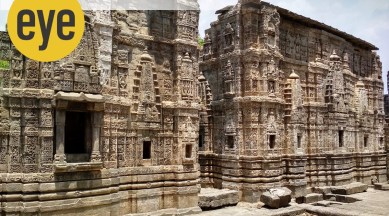When I had a slice of Tibet with my tea in Kangra Valley
In Kangra, where spirituality and culture converge, the scent of apple orchards wafts in the air and the Dhauladhar mountain range awaits seekers

On a sunny day in June 2019, we — my husband, our daughter and I — visit Kangra Fort. We have forgotten how hot even Himachal can get in peak summer, but a bottle of water from a shop outside the fort tides us over. Kangra Fort, the largest fort in the Himalayas (and the eighth largest in India) is a behemoth, not lightly approached.
Of course, that treasure couldn’t be hidden for long, and word spread. Over the years, one invader after another attacked Kangra Fort with an eye on its wealth. Alexander, some believe, was one of those; Mahmud of Ghazni definitely was (and he took many camel-loads of treasure back to Ghazni). Mohammad bin Tughlaq attacked, and then, Jahangir; so did Ranjit Singh, who — like Jahangir before him, and the British after — succeeded in capturing the fort.
On a hot afternoon, over a century after a cataclysmic earthquake destroyed much of the fort (in 1905), there’s no sign of the wealth. The fort’s walls march up the mountainside, past a 300-year-old peepal tree, to the ruins of the royal apartments, at the pinnacle. Intricately carved panels stand tall beyond the huge circular bases of vanished pillars.
And all around loom the mountains of Kangra. The most populous district of Himachal Pradesh, this is a land not just of cedars and snow, but much more. Tea, for one, which grows in green carpets blanketing the hills. Palampur, where we stay at the Taragarh Palace — once owned by the royal family of Kashmir, now a heritage hotel — is where the tea is at its most visible. Tea estates spread over the hills, the bushes abutting the road. Reetha trees, shady and laden with soap nuts, spread overhead, and red-billed blue magpies, bright-eyed and long-tailed, hop about.
In the grounds of the Taragarh Palace, more natural beauty awaits. Potted plants abound, but there’s more: a blurring of garden and wilderness — pink orchids hang, jewel-like, from a chinar tree; purple sunbirds flit, and babblers hop about in the shell ginger beside the swimming pool.
The coolness and the serenity envelop us even at the tea factory and gardens of the Wah Tea Estate. A cheesy name for a tea, I think (what? Wah, Wah? Instead of Wah, Taj?). But our guide, provided by the estate, explains. The estate is named for the (now Pakistani) town of Wah, hometown of Sikandar Ali Khan, who established this tea estate in 1857. The estate, sprawling across 500 acres, still flourishes, though no longer owned by the Khan family. The brewed tea, of which we are given several samples to taste, is imbued with the sunlight, the piney fragrance, the spirit of Kangra.
Tea is also grown in the district headquarters at Dharamshala (and its adjoining McLeod Ganj). But that seems to me more like tea for tourists than for the tea industry: the gardens here are compact, selfie-friendly ones beside the highway. Five minutes out of your car is all you need to get some great shots among the serried ranks of tea bushes.
Dharamshala, with its Tibetan connection (it has been the home of the Dalai Lama, and embodied in him the Central Tibetan Administration, since 1960), is cosmopolitan, touristy. Cafés line the narrow hill roads opposite souvenir-packed stalls. The Dalai Lama Temple is hectic with hordes of Indian tourists, chattering, photographing the huge gold-painted Buddha statue, and spinning the many prayer wheels that line the periphery of the prayer hall.
The Norbulingka Institute, which nurtures the arts and crafts of Tibet, is somewhat more refinedly touristy, perhaps because you need a sensitivity to appreciate the effort that goes into keeping alive a tradition in danger of annihilation. We wander about, admiring the work of the artisans and their apprentices: the metallurgy, the painting, the woodcarving, all exquisite.
We spent just 10 days in Kangra on this trip. Too little for more than a tantalising taste of the area. The Buddhist monasteries, the apple orchards, the tea gardens, the views of the snow-capped Himalayas: we have only just touched the surface. But, at each of the religious sites we visit — the Ambika Devi Temple at Kangra Fort, the Dalai Lama Temple and the Gyuto Tantric Monastery in Dharamshala, the atmospheric Church of St John in the Woods at Dharamshala — I offer up a prayer, not just for the usual peace, good health and blessings, but that the powers that be may allow us to return to Kangra. Again and again.
(Madhulika Liddle is an author based in the NCR. Apart from historical fiction and short stories, she also writes on food, cinema and travel)